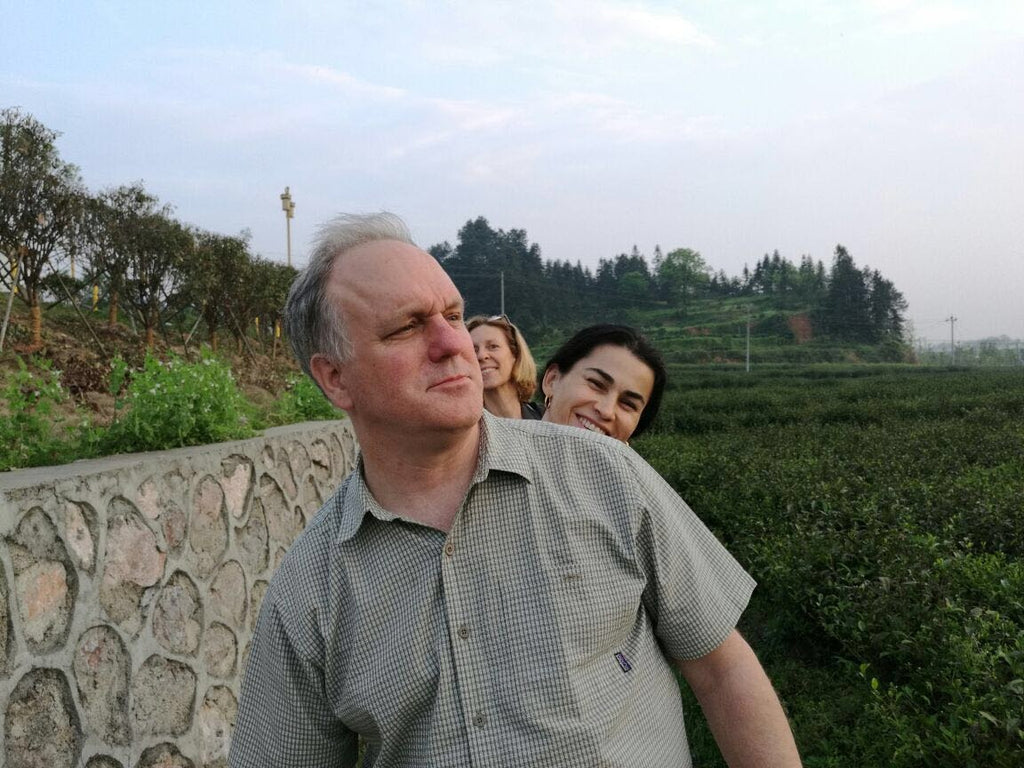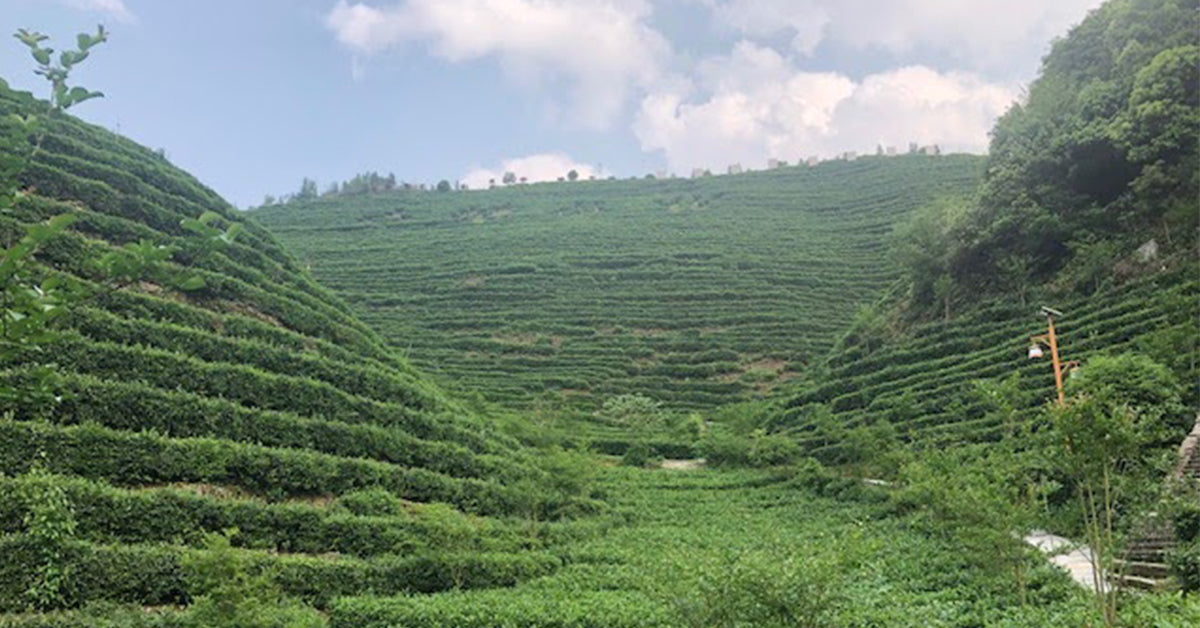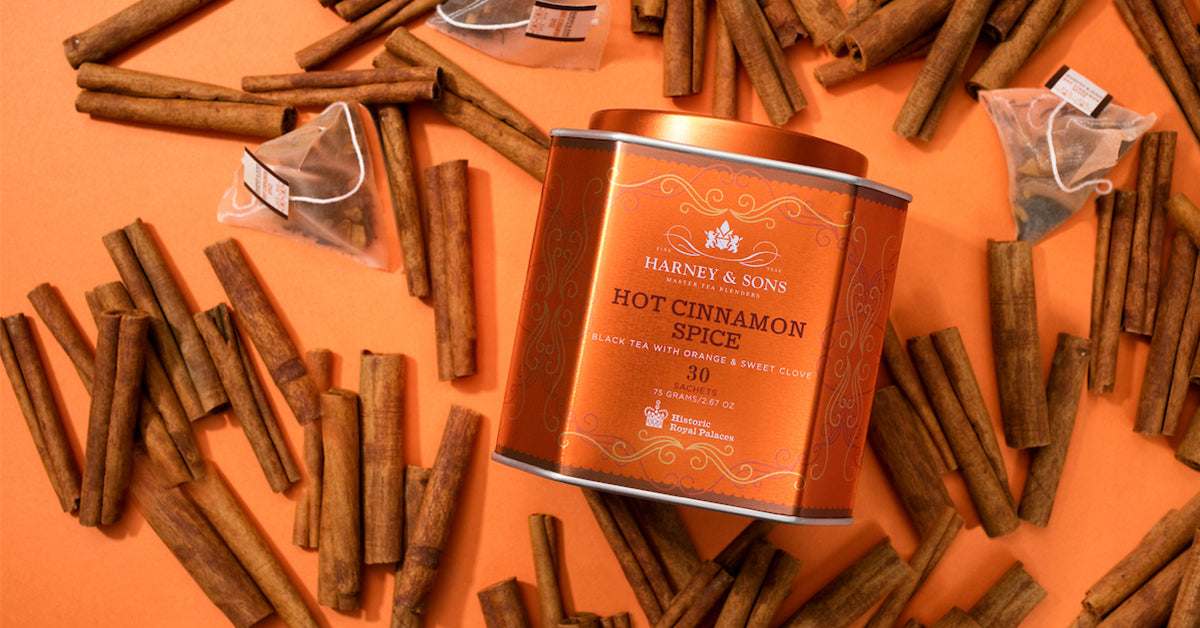Last month, we wrote about our first major Chinese tea-producing region, Fujian. This month, we’re back to take a trip to the second province we’re introducing you to Hunan. Our good friend in tea, Steve He, calls Hunan the Hometown of Tea. I’ve been visiting there for over 20 years.

Hunan is located in the south-central China region and has a population of roughly 69 million. Its capital and largest city are Changsha. The name “Hunan” means “south of the lake,” and the lake referred to is Dongting Lake, the second-largest freshwater lake in China and a Hunan icon. Dongting is famous for its yellow tea made on Junshan Island. We have carried that over the years; however, the price is very expensive, so Americans did not want to buy it. Emeric visited Dongting a few years back.
The Hunan province is located on the south bank of the Yangtze River. Its east, west, and south sides are surrounded by mountains and hills. Hunan is a popular tourist destination due in large part to its magnificent scenery, including Zhangjiajie National Forest Park and the majestic Mt. Hengshan, one of the most famous mountains in the country and a holy mountain for Taoists and Buddhists. Seeing Mt. Hengshan with its snow-capped peaks in the winter as it towers over the vast stretches of subtropical fields below is a sight to behold. In addition to natural beauty, Hunan is home to many ancient buildings and historic remains. The impressive Yueyang Tower is one of the most famous towers in Chinese history.

Another hallmark of Hunan is that it was the birthplace of the communist revolutionary Mao Zedong, who became the founder of the People’s Republic of China and was its chairman from 1949 until his death in 1976. Because of that association, Hunan is also called the cradle of China’s revolution.
When it comes to cuisine, Hunan is first and foremost associated with spicy food. The province is noted for its love of chili peppers as well as garlic, shallots, and other spices. If you don’t like hot, spicy food -- or if hot, spicy food does not like you -- then stay away from Hunan dishes. (The Hunanese have clearly adopted one Chinese adage, “Without chilies, you can’t eat rice.”) In addition to many traditional dishes you can get here in the U.S., like Mao shi hong shao rou (Chairman Mao’s red-braised pork), there is one dish that is uniquely Hunan: chou doufu, or stinky tofu.
The Hunanese are masters of fermentation, and that’s what stinky tofu is all about. The tofu is fermented in a dark black brine composed of many seasonings and, well, stinky things. When the time is right (or wrong, depending on how you feel about the smell), the tofu is taken from the brine and placed in a deep fryer, thus releasing the pungent odors which are described as anything from rotting garbage to rotten meat to smelly feet. Somehow, however, stinky tofu is said to be delicious, with some comparing it to the taste of blue cheese. It is said that the scent stays with you long after you’ve eaten it, like cigarette smoke on a jacket. Fortunately, drinking Hunan teas isn’t as traumatic as one’s first encounter with this uniquely Hunan street food.

Hunan has a long history of tea and is one of China’s largest producers. The subtropical climate with extremely hot/humid summers, short, cool winters, and plenty of rainfall provide an excellent place for tea to thrive. Hunan is the second-largest producer of tea in China, with grain, rice, and ramie being their primary products.
Famous tea areas in Hunan include Dongting Lake, Heng Mountain, and Shao Mountain, but since it is nearly 22,000 square kilometers in total area, there are many tea gardens in such a huge province. When we visit, we always enjoy going to different gardens to spend the night (and eat spicy local food!). We’ve even stumbled upon wild tea production, where farmers explore the woods and wild tea plants. The production of wild tea plants is very limited, sometimes just enough to fill a desk.

Steve He always takes me and my tea-tasting buddy, Elvira Cardenas, to some corner of the province to show the great tea made there. Steve works for Hunan Tea Corporation, which is the largest and best connected tea company in the province. Interestingly, it is the legacy company of the old government company that did all the tea in Hunan. Now, it is a for-profit company.

Image: Guishan Guanyin of the Thousand Hands and Eyes
We went to Weishan, which is where Chairman Mao hid and is now a big entertainment park with a huge Buddha. There we saw a lovely green tea made in early spring that is made by hand. On another trip to Furong, we walked in the forest, and they showed us wild tea. One time, we took a boat ride for hours and hours and went to an abandoned tea garden. It felt like an archaeological expedition. There is a big garden called Red Star that is popular with the party bigwigs. While we were there, all meals were based upon the smoked pork that is raised there. I tried my hand making some tea there. However we rejected it -- not good enough for you!
 Image: Mike Harney making tea
Image: Mike Harney making tea
Our last trip was to Gulou, which is up a lovely winding road near a big river. They told us that we were the first Western tea buyers that were there. We bought three great spring teas; here is a picture of us driving away with the stash!

Most years, our trip to Hunan Tea HQ is a big deal. Our names are on the message board in the lobby, and we taste teas all day long. That makes for a long day! They like to show all sorts of special teas. We have brought back a black oolong which we called Bloolong, it had haunting fruit flavors. Black King is always a favorite, but hard to come by. People love the intense flavor and natural sweetness. Yellow Sprout, White Fairy and Hunan Black Buds are just some of our discoveries.

The Hunan HQ is in the capital of Changsha. Although it is not a top 10 city in China, its population is more than Manhattan. Towers are sprouting from all over. I like to stay near the old section, where I can ramble through the old streets and markets. I also love the spicy food, however seven days of it add up. So far I have avoided stinky tofu.
This year, we will not make it back to Changsha. We will push Steve and his crew for some more fabulous teas, and hope for better luck next year. Our friends in Changsha say that the city is the hometown of Chinese teas. There is a large variety of tea, to be sure; this is the source of the basic black tea that we use in many Harney flavored teas. We make sure that the blend is only made from spring teas -- the best time to harvest them -- because like we always say, you should drink teas that make you smile!
Some teas we carry that are sourced from the Hunan province that you should try are listed below (get ready to smile). Whether you decide to see if they pair well with stinky tofu is up to you.
- Hunan Mao Jian. A product of the Changsha area, Hunan Mao Jian provides light, sweet flavors, and aromas that relax the senses and tempt the palate. Gentle grassy aromas with a note of smokiness complement a very light, delicate body that dances across the tongue with sweet hints of florals, vegetals, and just a touch of spiciness that lingers between sips. Mild and a touch mysterious, this beautiful tea provides a superb retreat from the troubles of life or simply a moment of relaxation on a clear afternoon.
- Green Gulou. Our last trip during our Chinese trip in 2019 was up to Gulou in Hunan Province. It turns out that we were the first Western tea buyers to visit this hidden valley about four hours south of Changsha. As we wound our way up the river valley, the air got fresher, and we got more excited. We stopped at the factory of Mrs. Xiao. She has run it for the last 13 years and built a beautiful garden that makes great teas. The Green Gulou comes from tea plants carefully tended in the steep hills above the factory. We were impressed with the body and sweetness of this tea. These desirable traits come from the umami found in the young tea leaves. The tea is fixed green, rolled and dried in ovens to preserve the sweetness.
- Furong Wild Black. While in Hunan, they showed us this wild tea. The next day, we went to look at the forest where wild tea plants grow taller than us! We absolutely loved the flavor (cooked apricots with mild cocoa notes at the finish) and body so we purchased everything they had (only five kilos!). We have this in limited stock. Use our search bar to find it!




